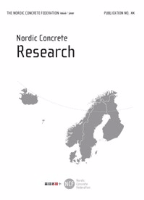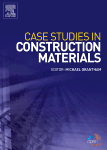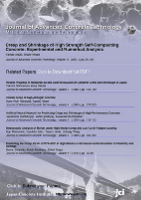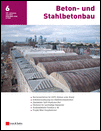
Nordic Concrete Research
Scope & Guideline
Shaping the Future of Concrete for Sustainable Construction
Introduction
Aims and Scopes
- Advanced Concrete Materials:
Focus on the development and characterization of innovative concrete materials, including high-performance, composite, and sustainable concretes that utilize alternative binders and supplementary cementitious materials (SCMs). - Durability and Performance Assessments:
Investigations into the durability of concrete structures under various environmental conditions, including frost-salt resistance, chloride ingress, and carbonation, are key themes, aimed at enhancing the longevity and performance of concrete in service. - Structural Integrity and Analysis:
Research on the structural behavior of concrete elements, including nonlinear analyses, fatigue performance, and the effects of alkali-silica reactivity (ASR), focusing on maintaining safety and reliability in concrete structures. - Innovative Construction Techniques:
Exploration of new construction methods, such as 3D printing, accelerated curing processes, and the use of digital technologies like BIM and digital twins, to improve efficiency and effectiveness in concrete construction and repair. - Sustainability in Concrete Practices:
Emphasis on sustainable practices in concrete production and recycling, including the use of industrial by-products, waste materials, and methods to reduce the carbon footprint in concrete applications.
Trending and Emerging
- Sustainable Concrete Practices:
There is a notable increase in research addressing sustainability, including the use of SCMs, recycled materials, and reducing carbon footprints in concrete production, reflecting a global push towards environmentally friendly construction practices. - Advanced Characterization Techniques:
Emerging methodologies for assessing concrete properties, such as non-destructive testing and advanced imaging techniques, are gaining traction, allowing for better understanding and monitoring of concrete performance over time. - Digital Technologies in Concrete Engineering:
The integration of digital tools such as BIM, digital twins, and advanced modeling techniques is becoming more prevalent, highlighting the industry's move towards leveraging technology for improved design, maintenance, and management of concrete structures. - Performance-Based Evaluation:
A shift towards performance-based evaluation of concrete materials and structures is evident, with increasing research on how various factors (e.g., curing conditions, environmental impacts) influence long-term durability and service life. - Innovations in Repair and Rehabilitation Techniques:
Research focusing on novel techniques for the repair and rehabilitation of concrete structures, particularly in relation to corrosion damage and fatigue performance, is on the rise, indicating a growing need for effective maintenance solutions.
Declining or Waning
- Traditional Concrete Mix Designs:
Research focusing solely on conventional concrete mix designs without the integration of advanced materials or performance metrics has decreased, as there is a growing trend towards innovative and hybrid materials. - Basic Concrete Testing Methods:
Studies centered around basic or traditional testing methods for concrete properties, such as simple compressive strength tests, are appearing less frequently, as researchers are seeking more comprehensive and sophisticated evaluation techniques. - Generalized Durability Studies:
While durability remains an essential topic, generalized studies without specific focus on innovative materials or unique environmental challenges are less common, indicating a shift towards more targeted investigations.
Similar Journals

Advances in Concrete Construction
Charting Progress in Concrete ScienceAdvances in Concrete Construction, published by TECHNO-PRESS in South Korea, is a pivotal academic journal dedicated to the fields of Building and Construction, Civil and Structural Engineering, and Mechanics of Materials. Established with the aim of fostering innovative research, this journal has rapidly gained recognition, achieving a commendable Q2 ranking across multiple categories, including Safety, Risk, Reliability, and Quality as of 2023. Featuring a blend of rigorous peer-reviewed articles, the journal serves as a vital platform for scholars, engineers, and students alike to disseminate cutting-edge research and practical applications in concrete construction technologies. Despite its absence of Open Access, the journal's inclusion in Scopus with notable rankings - such as #66 in Building and Construction - underscores its growing influence and commitment to quality as it converges on significant advancements from 2016 to 2024. By contributing to this respected journal, you join a community dedicated to exploring the future of sustainable and efficient construction practices.

Innovative Infrastructure Solutions
Leading the Charge in Sustainable Engineering Practices.Innovative Infrastructure Solutions is a leading academic journal published by Springer International Publishing AG, focusing on pioneering advancements in the fields of building and construction, civil and structural engineering, and environmental engineering. With an impact factor that reflects its significant role in the academic community, this journal serves as a vital platform for researchers, professionals, and students to disseminate groundbreaking studies and novel methodologies spanning diverse engineering disciplines. Since its inception in 2016, Innovative Infrastructure Solutions has steadily positioned itself within the Q2 category across several fields, including geotechnical engineering and engineering geology, as recognized in the 2023 quartiles. This reputable journal, accessible from Switzerland, not only emphasizes collaboration and knowledge exchange but also empowers innovators in infrastructure development globally. Whether you're contributing to a research project or seeking the latest findings, Innovative Infrastructure Solutions remains essential for anyone invested in advancing sustainable infrastructure solutions.

Case Studies in Construction Materials
Pioneering Research in Material Science ExcellenceCase Studies in Construction Materials, an esteemed journal published by Elsevier, provides a vital platform for the dissemination of scholarly research in the field of materials science, focusing particularly on innovations and advancements in construction materials. With its Q1 ranking in the 2023 Scopus category of Materials Science (Miscellaneous), the journal stands out for its high-impact contributions and commitment to enhancing industry practices. Open Access since 2014, Case Studies in Construction Materials promotes wide accessibility and engagement, encouraging collaborations among researchers, professionals, and students globally. Whether delving into innovative methodologies, sustainability in construction materials, or case studies that exemplify best practices, this journal is crucial for those seeking to advance the science and application of construction materials. Located in Amsterdam, Netherlands, its robust publication history from 2014 to 2024 ensures it remains a leading resource for contemporary research and academic exploration.

Cement Wapno Beton
Elevating Knowledge in Construction MaterialsCement Wapno Beton is a renowned academic journal published by STOWARZYSZENIE PRODUCENTOW CEMENTU, focusing on the intricate fields of building and construction, as well as materials science. With the ISSN number 1425-8129, this publication has been committed to advancing knowledge and fostering innovation since its inception in 2007, and it will continue until 2024. The journal operates within a competitive landscape, as reflected in its 2023 Scopus rankings, placing it in the third quartile (Q3) in both Building and Construction and Materials Science categories. Although it currently does not offer open access options, Cement Wapno Beton remains an essential resource for researchers, professionals, and students seeking valuable insights into the latest developments and technologies in construction materials. Its scope encompasses a wide range of topics, including architectural advancements, sustainable building practices, and innovative material applications, making it an indispensable tool for those dedicated to the evolution of construction science.

ACI STRUCTURAL JOURNAL
Elevating Structural Engineering Through Rigorous ResearchThe ACI Structural Journal, published by the American Concrete Institute, serves as a premier platform for scholarly articles and research findings in the fields of building and construction and civil and structural engineering. With a commitment to advancing concrete technology and its applications, this journal has amassed an impressive reputation, holding a Q2 ranking in both Building and Construction and Civil and Structural Engineering categories as of 2023. The journal’s focus on innovative research and practical applications enables professionals, researchers, and students to stay at the forefront of industry developments. Although it does not offer open access, the content bears significant impact, ensuring that readers engage with high-quality research. As the journal converges its years of publication from 1987 to 2024, it continues to enrich the academic and professional discussions surrounding structural engineering and concrete science.

R Journal
Empowering Researchers with Rigorous InsightsR Journal, published by the R Foundation for Statistical Computing, is a premier academic journal dedicated to advancing the fields of numerical analysis and statistical methodologies. With an ISSN of 2073-4859, the journal has established itself as a significant platform for high-quality research since its inception in 2009. It operates under a Q2 category ranking in respective fields, including Statistics and Probability, among others, highlighting its influence and relevance in the academic community. Researchers are encouraged to contribute their findings, as the journal appeals broadly to statisticians, mathematicians, and data scientists alike. Although not an open-access journal, its commitment to rigorous peer review ensures that published works maintain high standards of scientific integrity. The R Journal's vision is to foster innovative approaches within statistical computing, making it an invaluable resource for those seeking to deepen their understanding or stay abreast of developments in the discipline.

Journal of Advanced Concrete Technology
Innovative Insights into Concrete TechnologyThe Journal of Advanced Concrete Technology, published by the JAPAN CONCRETE INST, is a leading academic journal dedicated to the specialized field of concrete technology, offering invaluable insights and research findings that push the boundaries of knowledge in construction materials and engineering. With an ISSN of 1346-8014 and an E-ISSN of 1347-3913, this journal has been an influential platform since its inception in 2003, converging its focus through to 2024. The journal holds a commendable position within the Q2 category in both Building and Construction and Materials Science for 2023 and ranks in the 63rd and 47th percentiles, respectively, reflecting its significant contribution to these disciplines. Accessible only through traditional subscription models, it is a critical resource for researchers, professionals, and students looking to explore contemporary advancements in concrete applications and innovations. Engaging with this journal not only enables a deeper understanding of materials science but also fosters collaboration and dialogue within the global engineering community, making it an essential read for anyone invested in the future of construction technology.

Proceedings of the Institution of Civil Engineers-Construction Materials
Exploring Breakthroughs in Material ApplicationsProceedings of the Institution of Civil Engineers - Construction Materials is a leading journal dedicated to advancing the field of civil engineering, with a specific focus on construction materials. Published by Emerald Group Publishing Ltd in the United Kingdom, this journal serves as a critical platform for disseminating innovative research and practical applications in material science and structural engineering. With an ISSN of 1747-650X and E-ISSN 1747-6518, it spans an impressive timeline from 2006 to 2024, encapsulating pivotal studies that influence contemporary engineering practices. As a Q3 journal in the categories of Civil and Structural Engineering, Materials Science, and Mechanics of Materials, it reflects a solid academic standing, holding ranks of 152 out of 379 in Civil Engineering and 171 out of 398 in Mechanics of Materials, positioning itself within the esteemed scholarly community. The journal's objectives include promoting innovative material applications and fostering collaboration among professionals and researchers in the field. Although it does not currently offer open access, its comprehensive insights and findings are invaluable for researchers, professionals, and students striving for excellence in civil engineering and materials science.

Hormigon y Acero
Exploring New Frontiers in Construction ScienceHormigon y Acero, an esteemed journal published by the ASOC ESPANOLA INGENIERIA ESTRUCTURAL-ACHE, serves as a vital resource in the fields of structural engineering and construction. With an ISSN of 0439-5689 and an E-ISSN of 2605-1729, this journal plays a critical role in disseminating innovative research and advancements from 2019 to 2024, particularly focusing on concrete and steel applications. Although it does not currently offer open access, its contributions remain invaluable to professionals and academics seeking to enhance their understanding and practices in engineering disciplines. Ranked within the 13th percentile in Building and Construction and the 9th percentile in Civil and Structural Engineering according to Scopus, Hormigon y Acero is recognized for its rigorous peer-reviewed content that addresses contemporary challenges and innovations within the industry. The journal is positioned in Madrid, Spain, and aims to foster collaboration and knowledge exchange among researchers, practitioners, and students dedicated to the advancement of structural engineering.

Beton- und Stahlbetonbau
Elevating Standards in Building and ConstructionBeton- und Stahlbetonbau is a renowned journal published by ERNST & SOHN, dedicated to advancing knowledge in the field of building and construction, particularly focusing on concrete and reinforced concrete engineering. Established in 1969, this peer-reviewed publication encompasses a broad range of topics, including innovative construction methods, structural analysis, and material performance, making it a crucial resource for researchers, scholars, and industry professionals alike. With an impact factor ranking it within the Q2 category in the Building and Construction field, this journal holds significant influence, evidenced by its Scopus rank of #112/223. Importantly, Beton- und Stahlbetonbau is committed to providing high-quality content that meets the academic rigor demanded by its audience, ensuring that readers remain at the forefront of technological advancements and research in concrete construction.